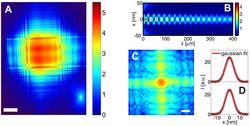Fig.1
At the coherence beamline P10 of PETRA III, scientists from University of Göttingen and DESY have focused the undulator beam by elliptical mirrors to 200 nm and coupled this beam into a set of two orthogonally aligned x-ray waveguides made of Germanium, Molybdenum and Carbon thin films, used for further reduction of the beam size and filtering. Only a discrete set of modes can propagate in the waveguides, leading to a highly coherent exit beam, which is then used as a quasi-point source for coherent imaging of specimen in projection geometry.
Fig.1 (A) shows the far-field intensity distribution of the 15 keV beam exiting the waveguide (scale bar 0.02 Å-1, measured with a pixel detector (Pilatus) at a distance of about 5 m behind the focus. The small focal width of the waveguide beam is evidenced by the large divergence angle. Inverting the diffraction pattern based on phase reconstruction by the error reduction algorithm, the near-field intensity distribution in the effective focal plane is obtained, as shown in (C). Least-square analysis of the central peak along the horizontal and vertical direction gives a width of 9.7 x 9.5 nm2 (FWHM), respectively. For comparison, simulation of beam propagation in one waveguide slice is shown in (B).
Fig.2 (B,C) show first reconstruction results, obtained from the phase-contrast holograms measured in projection geometry as shown in (A). In (B), the reconstructed phase of a Ta test pattern (Siemens star) is displayed (scale bar 8 µm), reconstructed by (holographic) back-propagation. (B) shows the phase distribution (scale bar 2 µm) of a freeze dried cell of the amoeba Dictyostelium discoideum, recorded in the same geometry, but now reconstructed by an iterative modified HIO algorithm.
Team of University Göttingen:
S.P. Krüger, M. Bartels, R. Wilke, S. Kalbfleisch, M. Priebe, M. Osterhoff, C. Olendrowitz, T. Salditt
HASYLAB/DESY: M. Sprung
The present (unpublished) work builds upon previous developments, published by T. Salditt et al. .







